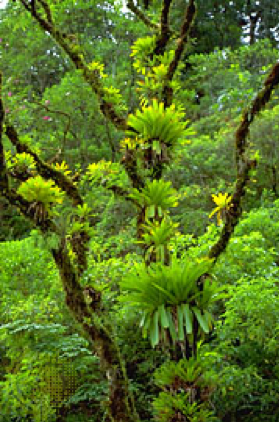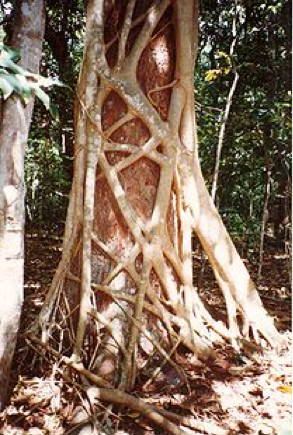Module 4: Tropical Forest Plant Growth Forms as Related to Natural Forest Management
Topic 4.4: Epiphytes and Hemiepiphytes
Epiphytes are plants that grow on other plants but that, unlike parasites, derive no nutrients or water directly from their host. Among the epiphytes is a wide diversity of species and growth forms. For example, there are epiphytic cacti, orchids, ferns, and mosses; some epiphytes are shrubs, some are vines, others develop large water‑holding rosettes in which numerous aquatic animals pass their entire lives, and some are tiny and live on the surfaces of leaves (= epiphylls). The abundance of epiphytes varies geographically and ecologically, being most common in fog‑drenched forests on nutrient‑rich soils at mid-elevations in the Neotropics. By increasing the surface areas of tree crowns, epiphytes can be important interceptors of mist and nutrients; in some montane forests, a substantial proportion of the stream water comes from this so‑called “horizontal rain” (which is not caught in standard rain gauges). Some orchids and other epiphytes are also important in the horticultural trade, and certainly add to the beauty of the forests in which they occur.


Figure 4.4.1. Epiphytes in a montane forest canopy (Bromeliaceae mostly; left). The roots of a stranger fig (Ficus spp.) that started its life up in the crotch of a branch of the tree it is now in the process of preventing from growing in diameter (i.e., strangling it; right)
Plants that spend part of their lives as epiphytes and part of their lives rooted in the ground are called “hemiepiphytes.” Strangler figs are perhaps the most familiar of the hemiepiphytes, but the growth habit is found in more than 20 families and several hundred species of plants. Some hemipepiphytes start out on the ground and later in life grow as epiphytes (e.g., Philodendron, Monstera, and other Araceae), but most start out in the crown of a tree and produce roots that grow downward. In the case of strangler figs, the roots may eventually surround and girdle the trunk of the host tree with a woody cylinder that then serves to hold up the fig’s crown after the host has died and decomposed (Figure 3.3: strangler fig life cycle). Because survival and growth of strangler fig seedlings depends on their finding humus‑filled cavities in which to root, most of the trees strangled by figs are hollow anyway and thus of little commercial value. The figs themselves may be of tremendous value, in contrast, as sources of fleshy fruits for wildlife in times of fruit scarcity. Due to their peculiar system of pollination, figs can be found in fruit throughout the year; fig fruits are easily digested, and the lists of animal species that feed on them are exceedingly long.

Figure 4.4.2. Strangler figs (Ficus spp.) and other primary hemiepiphytes start their lives as epiphytes but later become connected to the ground by downward growing roots. The anastomosing roots of stranglers, of which there are many species, then form a woody sheath around the trunk of their host tree, preventing its diameter growth, which eventually causes its demise due to failure to replace cavitated xylem vessels and dysfunctional phloem sieve tubes.
